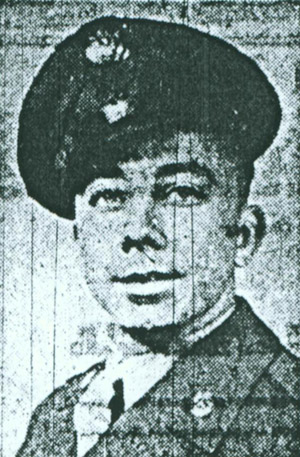
Charleston Gazette

Remember...
Paul Brown Armentrout
1932-1953
"In the military, I learned that 'leadership' means raising your hand and volunteering for the tough, important assignments."
Tulsi Gabbard
Army Private First Class Paul Armentrout's father, Thomas Farrell Armentrout, was the son of a Presbyterian minister. Thomas served in the U.S. Army during World War I from August 30, 1918, until April 8, 1919. After his military service he was employed by the State of West Virginia as an auto mechanic.
Thomas Armentrout and Lucy Agnes Watts were married at Ronceverte, Greenbrier County, West Virginia, on December 28, 1921. They became the parents of eight sons and three daughters: Daisy Virginia (Mrs. James Tate McNutt), Thomas F. Jr., James D., Henry W., Mary Ethel (Mrs. Dale Jennings), Paul Brown, Richard P., Jean Agnes (Mrs. John Buren Foster), Robert H., William L., and L. Frank.
Thomas Sr. died on November 25, 1983, and his wife, Lucy, died on September 15, 1988. They are buried in a family plot in Sunset Memorial Park at South Charleston along with their sons who served in the armed forces, William, Paul, and Frank.
In the early 1950s the family moved to Rand in Kanawha County. On October 15, 1952, Paul enlisted in the U.S. Army. He was assigned to the 516th Airborne Infantry Regiment of the 101st "Screaming Eagles" Airborne Division. Paul was stationed at Camp Breckenridge, Kentucky, for basic training.
The history of the 101st Division goes back to World War I, and, as some would have it, the Civil War, it being an outgrowth of the Organized Reserves, the successor to the Wisconsin volunteer regiments. The 101st Airborne, one of the most decorated in American history, was reactivated in 1942. In World War II it played a major role in D-Day, Operation Market Garden, and the Battle of the Bulge. Deactivated in 1945, it became part of the regular army in 1948 and was reactivated and stationed at Camp Breckenridge, Kentucky, in 1949. There it served as a training unit during the Korean War, was deactivated in 1953, and then reactivated in 1954. By 1956 it was stationed at Fort Campbell, Kentucky. In 1957, interestingly, it was members of the 101st Airborne who escorted the "Little Rock Nine" into school, thus earning a place in civil rights history. Later, it would play a major role in the Vietnam conflict. (Source: U.S. Army Center of Military History, "Lineage and Honors Information: Headquarters and Headquarters Company: 101st Airborne Division (Screaming Eagles)," Web, accessed 22 June 2015.)
On March 5, 1953, Pfc. Paul Brown Armentrout, while serving as an assistant instructor on the 18-millimeter mortar range at Camp Breckenridge, was struck by shell fragments during a training exercise. Death was instantaneous. Fourteen other soldiers were injured during the explosion, which was determined to have been caused by a faulty fuse.
Article prepared by Leon Armentrout.
May 2015

West Virginia Archives and History welcomes any additional information that can be provided about these veterans, including photographs, family names, letters and other relevant personal history.